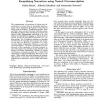726 search results - page 81 / 146 » Reasoning about Feature Models in Higher-Order Logic |
111
click to vote
FMCO
2007
Springer
15 years 6 months ago
2007
Springer
This article considers the coordination language Reo, a Petri net variant called zero-safe nets, and intuitionistic temporal linear logic (ITLL). The first part examines the seman...
111
click to vote
ICTAI
2007
IEEE
15 years 6 months ago
2007
IEEE
We review a method of generating logical rules, or axioms, from empirical data. This method, using closed set properties of formal concept analysis, has been previously described ...
116
click to vote
ECMDAFA
2006
Springer
15 years 3 months ago
2006
Springer
Abstract. The Unified Modelling Language (UML) is intended to describe systems, but it is not clear what systems satisfy a given collection of UML diagrams. Stephen Mellor has desc...
106
click to vote
AAAI
1996
15 years 1 months ago
1996
The representation of narratives of actions and observations is a current issue in Knowledge Representation, where traditional plan-oriented treatments of action seem to fall shor...
104
click to vote
ECAI
2010
Springer
15 years 1 months ago
2010
Springer
Abstract. Interval temporal logics formalize reasoning about interval structures over (usually) linearly ordered domains, where time intervals are the primitive ontological entitie...

